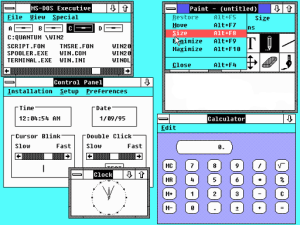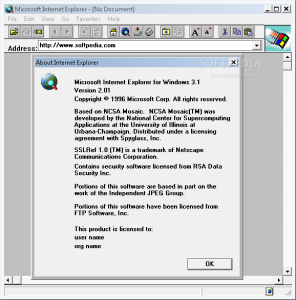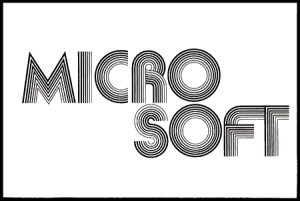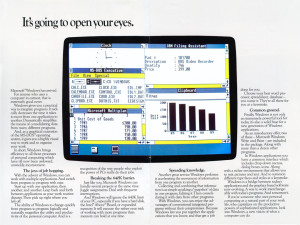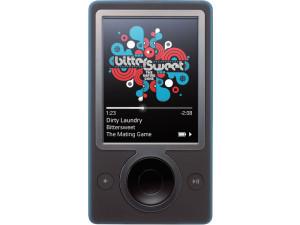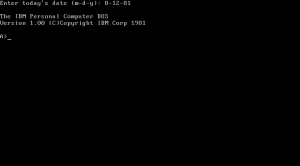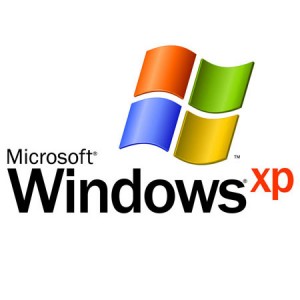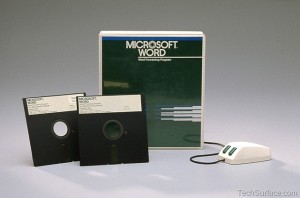Microsoft
Windows 2.0 Released
Microsoft releases version 2.0 of Windows. The most notable feature of Windows 2.0 was that application windows could overlap each other, unlike in Windows 1.0. The terminology of “Minimize” and “Maximize” was also introduced in Windows 2.0.
Windows 2.0 was a relatively obscure operating system, as the popularity of Windows did not really take off until version 3 in the 1990’s. Interestingly, Microsoft officially supported Windows 2.0 until December 31, 2001, a span of 14 years.
All that being said, Windows 2.0 is probably more important in computer history for being the version of Windows that prompted Apple’s famous lawsuit against Microsoft for copyright infringement of the Macintosh operating system.
Microsoft Ships Internet Explorer 2.0
Nearly 6 months to the day after Bill Gates sent his Internet Tidal Wave memo recognizing the importance of the Internet, and only 3 months after releasing version 1.0, Microsoft releases Internet Explorer 2.0 for Windows 95 and Windows NT 3.5. IE 2.0 was still based on licensed code from Spyglass Mosaic, but was the first IE version to support now-common features such as SSL, JavaScript, and cookies. It was also the first version to allow the importing of bookmarks from Netscape Navigator, which at the time had a virtual monopoly on the web browser market. This was the first inklings of the “browser war” that was soon to erupt over the next few years.
Microsoft Trademarked
November 26, 1976
Bill Gates and Paul Allen register the trade name “Microsoft” with the Office of the Secretary of State of New Mexico. Previously, Gates and Allen had been working under an informal partnership known as “Micro-soft”, a combination of Microcomputer and Software. The partnership continued for several more years until Microsoft incorporated in July of 1981, just prior to the introduction of the IBM PC.
Windows 1.0 Ships
Two years after initially being announced, Microsoft finally ships the first version of Windows. Originally slated to be shipped in April of 1984, the long delay caused skeptics to began to accuse Windows of being “vaporware”. Due to the relatively high demands of then-current PC technology, Windows 1.0 was generally considered too slow to be usable. It wasn’t until Windows 3 that the operating system began to generate significant sales.
Microsoft Introduces Zune
Knock-knock
Who’s there?
Microsoft Zune.
Microsoft Zune who?
Exactly.
Microsoft releases their Zune media player, intended to compete with Apple’s iPod. Hailed by some as an “iPod-killer”, the only killing done was by Microsoft less than 5 years later when they ended production of the Zune brand. Otherwise known as simply another media player to fall to the iPod behemoth, the Zune is considered a spectacular failure when taking into account the weight of the Microsoft brand at the time. The Zune’s lack of success foreshadowed of the decline of Microsoft in The New World of Technology, once Apple introduced the iPhone and iPad effectively ending the PC Era.
Microsoft Declares Tablets Are the Future
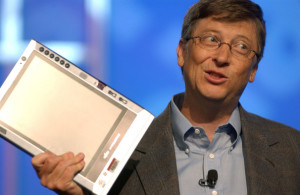
Bill Gates demonstrates a functional prototype of a Tablet PC. Microsoft claims “the Tablet PC will represent the next major evolution in PC design and functionality.” However, the Tablet PC initiative never really takes off and it isn’t until Apple introduced the iPad in 2010 that tablet computing is widely adopted.
In my opinion, Microsoft’s failure with the Tablet PC initiative was threefold. First, they simply tried to adapt Windows, an operating system designed for use with a keyboard and mouse, for use with a touchscreen/pen interface. Users never really warmed up to the awkward hybrid interface. Second, by their own words they were “incorporating the convenient and intuitive aspects of pencil and paper into the PC experience.” Rather than innovating, it appears to me that Microsoft was moving backwards by trying to graft an older paradigm (pencil and paper) onto a computer. It’s one thing to create an app or peripheral that mimics pencil and paper – it’s another to base an entire technology initiative around it. Finally, Microsoft left the design of the hardware to their OEM partners, most of whom are not especially well-known for innovating designs. Most Tablet PCs were considered too big, heavy, and expensive, plus the required pen/stylus was prone to loss. All of these factors left many Tablet PCs collecting dust if they were sold at all.
Likely the lessons that Microsoft learned from this early effort led to Microsoft manufacturing their own hardware for their Surface Tablets starting in the late 2010s, mimicking the model that Apple proved successful.
Microsoft Introduces Windows
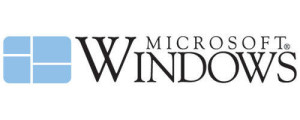
Microsoft formally announces Windows, a graphical user interface for Microsoft DOS-based systems. Bill Gates promises that Windows will ship by April of 1984. However, in true Microsoft fashion, Windows 1.0 doesn’t actually ship until November 1985. While Windows 1 and Windows 2 saw limited usage, it wasn’t until Windows version 3 that Windows began to see widespread acceptance.
IBM Signs A Deal With The Devil
IBM and Microsoft formally sign an contract whereby Microsoft will create an operating system for the in-development IBM PC. During the summer of 1980, IBM was originally interested in licensing the popular CP/M operating system, but the inability to come to an agreement with Digital Research led IBM to ask Microsoft if they could develop an operating system similar to CP/M. Microsoft was already going to work with IBM to deliver their BASIC programming language for the IBM PC, but they did not have an operating system. However, Microsoft knew that a small company named Seattle Computer Products had developed an operating system similar to CP/M called QDOS, for Quick-and-Dirty Operating System. Microsoft suggested to IBM that QDOS could work as the IBM PC’s operating system. IBM asked Microsoft to license and further develop the operating system, which led to the formal contract on November 6, 1980. After the contract was signed, in December 1980 Microsoft would license the QDOS operating system to begin development of the IBM PC version. In July of 1981, just weeks before the IBM PC would ship, Microsoft purchased full rights from SCP for what was now called 86-DOS. IBM PC-DOS was the name of the operating system that would ship on the IBM PC, but it was Microsoft that wholly developed the operating system after acquiring it from SCP.
Microsoft shrewdly included a clause in the agreement that allowed them to sell the operating system to other companies under the name MS-DOS. It was this clause that changed the course of technology history, opening the door for Microsoft to become the dominant technology company of the PC era. Microsoft seemed to understand that by controlling the operating system, the underlying hardware became less relevant. IBM obviously did not consider this concept, nor did they foresee that companies would be able to successfully clone their hardware platform. Once companies were able to clone the hardware, they needed an operating system. Microsoft was more than happy to provide them with that operating system, which by design was completely compatible with IBM’s PC-DOS. Once IBM lost control of the platform they created, power shifted to the one major commonality between the IBM-compatible clones: Microsoft’s operating system. It was IBM’s name that pushed the IBM PC into prominence, but it was the combination of hardware cloning and Microsoft licensing the operating system that created the dominant platform of the PC era, crushing nearly all competing personal computer platforms in the process. Without this seemingly minor clause in this pivotal contract, the history of the PC era could have been quite different than it was.
Windows XP Released
Microsoft releases the operating system Windows XP, the successor to both Windows 2000 and Windows ME. Designed to unify the Windows NT line and Windows 95 line of operating systems, Windows XP was not replaced by Microsoft until January 2007 with Windows Vista. However, with a nearly six-year run and the public debacle surrounding the release of Windows Vista, Windows XP remained the world’s most popular operating system until August 2012.
Microsoft Word 1.0 for DOS
Microsoft releases their first software application, Microsoft Word 1.0. For use with MS-DOS compatible systems, Word was the first word processing software to make extensive use of a computer mouse. Not coincidentally, Microsoft had released a computer mouse for IBM-compatible PCs earlier in the year. A demo version was also included for free with a copy of PC World magazine, marking the first time a floppy disk was included with a magazine.

